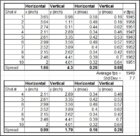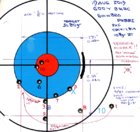I have been using my ShotMarker (SM henceforth) for about three months, and have compared the data from SM, both the CSV exported report and the target displayed, with the actual paper target. So far, I have been very pleased, as if there are any discrepancies, they are in the order of around 0.07” or less.
Here is an example of how I compare the data from shooting yesterday. I was testing four loads, and setup the SM target with a center for the initial zeroing, and four bulls set at 45°, 4-1/2” from the center. The SM display allows me to see how close I am to the bulls (estimate the location), and I may do some minor scope adjustments along the way. I am not interested in the absolute location of the shots, but rather on how well they group together.
This particular one was the first target I shot after shooting several zeroing rounds, and as you can see below, the first three rounds appeared to be too low, so I adjusted the scope up 4/8-MOA, and fired the remaining seven rounds without any further adjustments.
Just to see how the group may looked like if I had the scope adjusted properly to start, theoretically, I ‘moved’ the first three shots up 1/2-MOA, or 3 inches up. This did not affect the vertical dimension of the group, but made it a bit wider. There was a mild (3-4 mph) breeze from 10:00 o’clock.
In the Actual target, you can see the first sighter, S1, and the last, S6. But when I started the test and aimed at the upper right bull (the one shown), the shots were too low because I had used a higher charge for the sighters.
ACTUAL – I use the traditional methods to measure the distances, and divide by 6.24 to convert to MOA (600 yards).
DISPLAY – To measure the distances on the displayed target, I use the X-Ring diameter as 3-inches, and scale the other dimensions from that.
REPORT – I add one line to the Excel spread sheet to provide the vertical and horizontal spreads, which is very easy to do. To analyze just the seven-shots, I used only those rows of data.
ACTUAL - The Paper Target
View attachment 1121151
DISPLAY - Screen Capture
View attachment 1121152
Excel Data - For 10 Rounds, For 7 Rounds, Comparison
View attachment 1121153
View attachment 1121154
Just sharing . . .
Alex
















